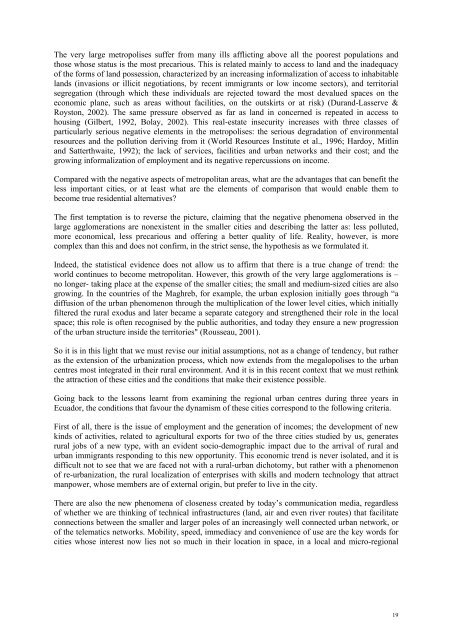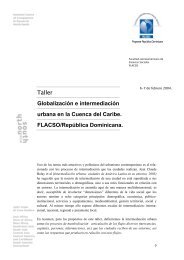interfase urbano-rural en ecuador hacia un desarrollo territorial ...
interfase urbano-rural en ecuador hacia un desarrollo territorial ...
interfase urbano-rural en ecuador hacia un desarrollo territorial ...
You also want an ePaper? Increase the reach of your titles
YUMPU automatically turns print PDFs into web optimized ePapers that Google loves.
The very large metropolises suffer from many ills afflicting above all the poorest populations and<br />
those whose status is the most precarious. This is related mainly to access to land and the inadequacy<br />
of the forms of land possession, characterized by an increasing informalization of access to inhabitable<br />
lands (invasions or illicit negotiations, by rec<strong>en</strong>t immigrants or low income sectors), and <strong>territorial</strong><br />
segregation (through which these individuals are rejected toward the most devalued spaces on the<br />
economic plane, such as areas without facilities, on the outskirts or at risk) (Durand-Lasserve &<br />
Royston, 2002). The same pressure observed as far as land in concerned is repeated in access to<br />
housing (Gilbert, 1992, Bolay, 2002). This real-estate insecurity increases with three classes of<br />
particularly serious negative elem<strong>en</strong>ts in the metropolises: the serious degradation of <strong>en</strong>vironm<strong>en</strong>tal<br />
resources and the pollution deriving from it (World Resources Institute et al., 1996; Hardoy, Mitlin<br />
and Satterthwaite, 1992); the lack of services, facilities and urban networks and their cost; and the<br />
growing informalization of employm<strong>en</strong>t and its negative repercussions on income.<br />
Compared with the negative aspects of metropolitan areas, what are the advantages that can b<strong>en</strong>efit the<br />
less important cities, or at least what are the elem<strong>en</strong>ts of comparison that would <strong>en</strong>able them to<br />
become true resid<strong>en</strong>tial alternatives<br />
The first temptation is to reverse the picture, claiming that the negative ph<strong>en</strong>om<strong>en</strong>a observed in the<br />
large agglomerations are nonexist<strong>en</strong>t in the smaller cities and describing the latter as: less polluted,<br />
more economical, less precarious and offering a better quality of life. Reality, however, is more<br />
complex than this and does not confirm, in the strict s<strong>en</strong>se, the hypothesis as we formulated it.<br />
Indeed, the statistical evid<strong>en</strong>ce does not allow us to affirm that there is a true change of tr<strong>en</strong>d: the<br />
world continues to become metropolitan. However, this growth of the very large agglomerations is –<br />
no longer- taking place at the exp<strong>en</strong>se of the smaller cities; the small and medium-sized cities are also<br />
growing. In the co<strong>un</strong>tries of the Maghreb, for example, the urban explosion initially goes through “a<br />
diffusion of the urban ph<strong>en</strong>om<strong>en</strong>on through the multiplication of the lower level cities, which initially<br />
filtered the <strong>rural</strong> exodus and later became a separate category and str<strong>en</strong>gth<strong>en</strong>ed their role in the local<br />
space; this role is oft<strong>en</strong> recognised by the public authorities, and today they <strong>en</strong>sure a new progression<br />
of the urban structure inside the territories" (Rousseau, 2001).<br />
So it is in this light that we must revise our initial assumptions, not as a change of t<strong>en</strong>d<strong>en</strong>cy, but rather<br />
as the ext<strong>en</strong>sion of the urbanization process, which now ext<strong>en</strong>ds from the megalopolises to the urban<br />
c<strong>en</strong>tres most integrated in their <strong>rural</strong> <strong>en</strong>vironm<strong>en</strong>t. And it is in this rec<strong>en</strong>t context that we must rethink<br />
the attraction of these cities and the conditions that make their exist<strong>en</strong>ce possible.<br />
Going back to the lessons learnt from examining the regional urban c<strong>en</strong>tres during three years in<br />
Ecuador, the conditions that favour the dynamism of these cities correspond to the following criteria.<br />
First of all, there is the issue of employm<strong>en</strong>t and the g<strong>en</strong>eration of incomes; the developm<strong>en</strong>t of new<br />
kinds of activities, related to agricultural exports for two of the three cities studied by us, g<strong>en</strong>erates<br />
<strong>rural</strong> jobs of a new type, with an evid<strong>en</strong>t socio-demographic impact due to the arrival of <strong>rural</strong> and<br />
urban immigrants responding to this new opport<strong>un</strong>ity. This economic tr<strong>en</strong>d is never isolated, and it is<br />
difficult not to see that we are faced not with a <strong>rural</strong>-urban dichotomy, but rather with a ph<strong>en</strong>om<strong>en</strong>on<br />
of re-urbanization, the <strong>rural</strong> localization of <strong>en</strong>terprises with skills and modern technology that attract<br />
manpower, whose members are of external origin, but prefer to live in the city.<br />
There are also the new ph<strong>en</strong>om<strong>en</strong>a of clos<strong>en</strong>ess created by today’s comm<strong>un</strong>ication media, regardless<br />
of whether we are thinking of technical infrastructures (land, air and ev<strong>en</strong> river routes) that facilitate<br />
connections betwe<strong>en</strong> the smaller and larger poles of an increasingly well connected urban network, or<br />
of the telematics networks. Mobility, speed, immediacy and conv<strong>en</strong>i<strong>en</strong>ce of use are the key words for<br />
cities whose interest now lies not so much in their location in space, in a local and micro-regional<br />
19




